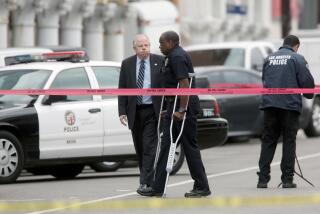Opinion: If it weren’t for video, would this be another justifiable homicide?
- Share via
The decision by authorities to charge North Charleston, S.C., police Officer Michael T. Slager with murder in the shooting Saturday of 50-year-old Walter Scott who was unarmed and running away is remarkable in two important ways.
First, when police officers say they feared for their lives to justify use of force, it is generally enough to exonerate them. The cases of officers charged with murder are so rare as to be statistically nonexistent. Rightly or wrongly, this has been the source of the national outrage over high-profile cases of deadly force in Ferguson, Mo., New York City and Pasco, Wash., among others.
Of course, an officer must be able to shoot to kill when faced with a threat to his or her life. The danger to police officers is real, as has been illustrated by the recent execution of two officers in New York City by a deranged man and the shooting of two Ferguson, Mo., police officers in March during a protest.
Secondly, it bolsters the argument for body cameras on officers, and public access to the footage.
Were it not for a video of the event taken by a bystander, Slager’s version of events would have likely held sway, since the only one to dispute it was dead and even in life wasn’t a credible source. According to reports, Scott was a petty scofflaw who had been arrested 10 times in the past, mostly for not paying child support. Not a pillar of the society, him.
The video shows a more troubling view that’s difficult to dispute: that the officer was in no danger from the fleeing man, who had been stopped for a broken taillight and already shocked by Slager’s stun gun. The citizen video shows Officer Slager calmly shooting eight rounds as Scott fled, then walking over to the prone and dying man to cuff him, which at first seems nonsensical but later seems more sinister. Then Slager is seen walking back to where he was standing when he fired the shots, picks something up, then walks back over to Scott and drops it on the ground.
Not good for Slager, who was fired Wednesday. Even Republican Sen. Lindsey Graham called it “deeply troubling.” As the actor and comedian DL Hughley so aptly put it in a tweet: “Cop who killed #WalterScott & planted evidence isn’t being tried 4 murder cuz THEY saw what he did..he’s being tried cuz WE saw what he did.”
A writer at Huffington Post took that idea one step further and penned the story that we might have seen if this video had not surfaced. It starts:
“This article is written as if the alleged murder of Walter Scott had not been captured on video that was made public Tuesday by The New York Times and other outlets.
A North Charleston police officer was forced to use his service weapon Saturday during a scuffle with a suspect who tried to overpower him and seize the officer’s Taser, authorities said.
The man, who has a history of violence and a long arrest record, died on the scene as a result of the encounter, despite officers performing CPR and delivering first aid, according to police reports.”
Will the nation look back at the killing of Walter Scott as a turning point in the use of deadly force by officers? Maybe. If so, we can’t discount the role the public release of the video played here.
Follow the Opinion section on Twitter @latimesopinion and Facebook
More to Read
A cure for the common opinion
Get thought-provoking perspectives with our weekly newsletter.
You may occasionally receive promotional content from the Los Angeles Times.







